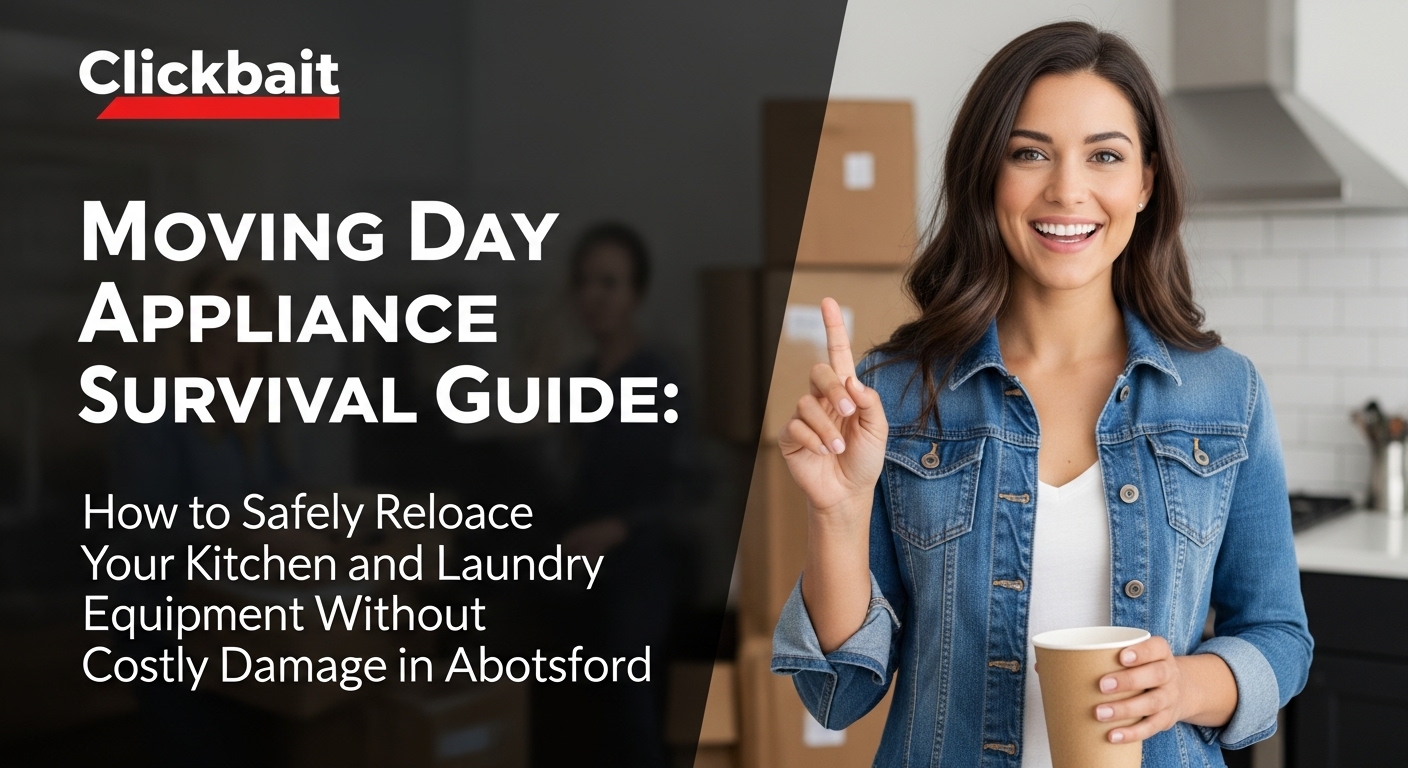Moving your precious appliances during a big relocation and worried they won’t survive the journey? Don’t stress – we’ve got the complete survival guide to keep your kitchen and laundry equipment safe from costly damage during your Abbotsford move!
Picture this: You’re standing in your empty kitchen, watching the moving truck pull away, only to discover your beloved stainless steel refrigerator has a massive dent and your washing machine is making weird noises it never made before. Ugh, the absolute worst, right? Moving appliances isn’t just about shoving them in a truck and hoping for the best – it’s actually one of the most complex parts of any relocation, especially here in Abbotsford where our unpredictable weather can throw extra curveballs your way. These aren’t just heavy boxes we’re talking about; they’re sophisticated machines with delicate internal components, electronic systems, and moving parts that can easily turn into expensive paperweights if handled incorrectly.
The reality is that most people seriously underestimate what goes into safely relocating kitchen and laundry equipment. Your refrigerator has a complex cooling system that can be permanently damaged if tilted wrong. Your washer has an internal drum that needs special stabilizing bolts to prevent it from bouncing around like a pinball during transport. And don’t even get me started on gas appliances – one wrong move and you’re looking at serious safety hazards. But here’s the thing: with the right knowledge, proper timing, and smart preparation, you can totally nail this move without breaking the bank or your back.
What makes appliance moving even trickier in Abbotsford is that we’re dealing with everything from Fraser Valley rain to temperature swings that can affect these sensitive machines during transport. Plus, navigating through some of our older neighborhoods with narrow driveways and tight corners adds another layer of complexity. The good news? We’ve got an amazing local network of appliance services and moving professionals who know exactly how to handle these challenges.
Key Outtakes:
- Proper preparation 24-48 hours before moving day is absolutely essential for appliance safety and functionality
- Most professional movers won’t disconnect or reconnect your appliances, so you’ll need separate arrangements for this crucial step
- Basic moving company liability only covers 60 cents per pound, making additional insurance coverage a smart investment for expensive appliances
- Different appliances require specific preparation procedures to prevent internal damage – one size definitely doesn’t fit all
- Abbotsford has excellent same-day appliance installation and repair services to help get you back up and running quickly
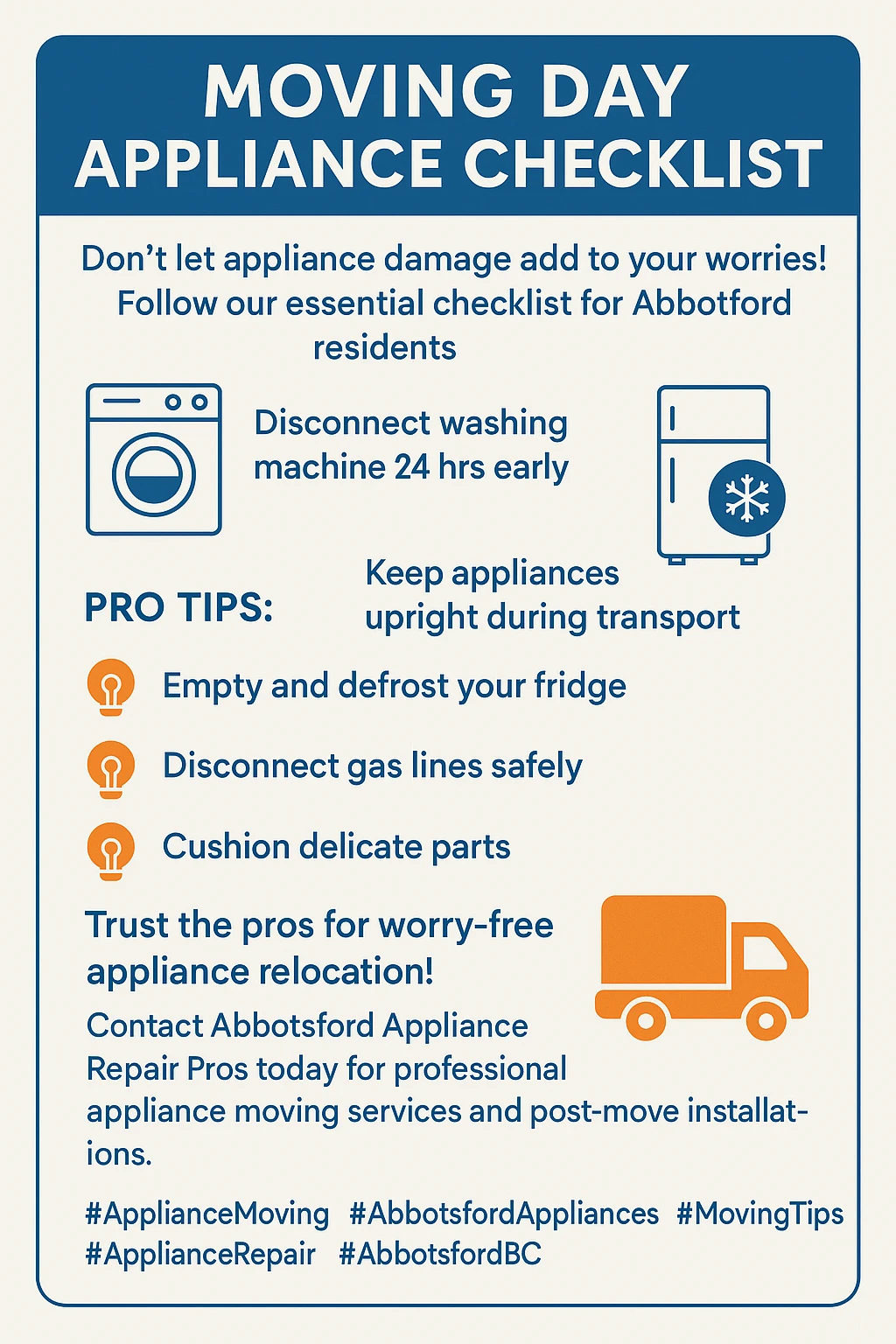
Understanding Why Appliance Moving Requires Special Planning
Before we dive into the nitty-gritty details, let’s talk about why moving appliances is so much more complicated than relocating your couch or dining table. These machines aren’t just heavy objects – they’re intricate systems with compressors, pumps, heating elements, and electronic controls that can be seriously damaged if not handled properly. Think of your refrigerator as having a circulatory system where coolant flows through coils and tubes. If you tip it the wrong way, that coolant can flow into places it shouldn’t be, potentially killing your compressor and leaving you with a very expensive decoration.
Your washing machine presents its own unique challenges with that heavy drum inside that’s designed to spin at high speeds. During normal operation, it’s perfectly balanced and controlled, but during a move, that drum can become a wrecking ball if it’s not properly secured. 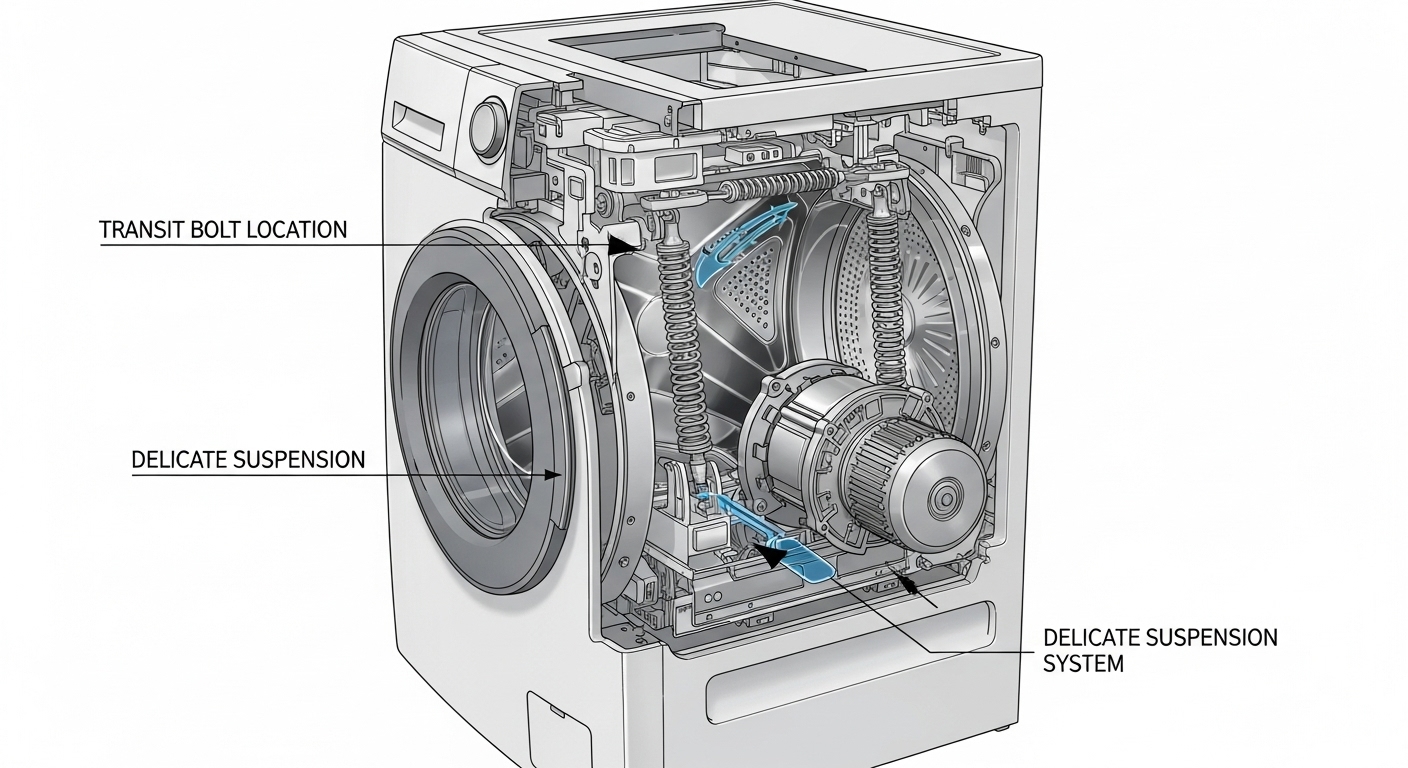 The internal mechanisms need special transit bolts to keep everything stable, just like the ones that came with the machine when it was first delivered to your home.
The internal mechanisms need special transit bolts to keep everything stable, just like the ones that came with the machine when it was first delivered to your home.
Gas appliances add another layer of complexity because they involve safety considerations beyond just preventing damage. Any gas line disconnection needs to be handled by qualified professionals to prevent leaks or other hazardous situations. Even electric appliances have sensitive electronic components that can be damaged by static electricity, vibration, or temperature extremes during transport.
The weight factor alone makes appliance moving challenging. A standard refrigerator can weigh anywhere from 200 to 400 pounds, and that’s when it’s empty. These aren’t just heavy – they’re awkwardly shaped with protruding handles, doors, and an uneven weight distribution that makes them difficult to grip and maneuver. Without proper equipment and technique, you’re looking at potential injury to yourself and damage to both the appliance and your home’s floors, walls, and doorways.
Environmental factors during transport can also impact appliance functionality. Temperature fluctuations, moisture exposure, and vibration during the journey can all affect sensitive components. Here in Abbotsford, where we can experience everything from heavy winter rains to hot summer days, protecting your appliances from the elements becomes an additional consideration that many people overlook.
The Critical 48-Hour Preparation Timeline
Here’s where most people mess up big time – they think appliance prep can be handled the morning of moving day. Wrong! The preparation process needs to start at least 48 hours before the movers arrive, and for some appliances, you’ll want even more lead time. This isn’t just about being organized; it’s about giving your appliances the time they need to reach the proper state for safe transport.
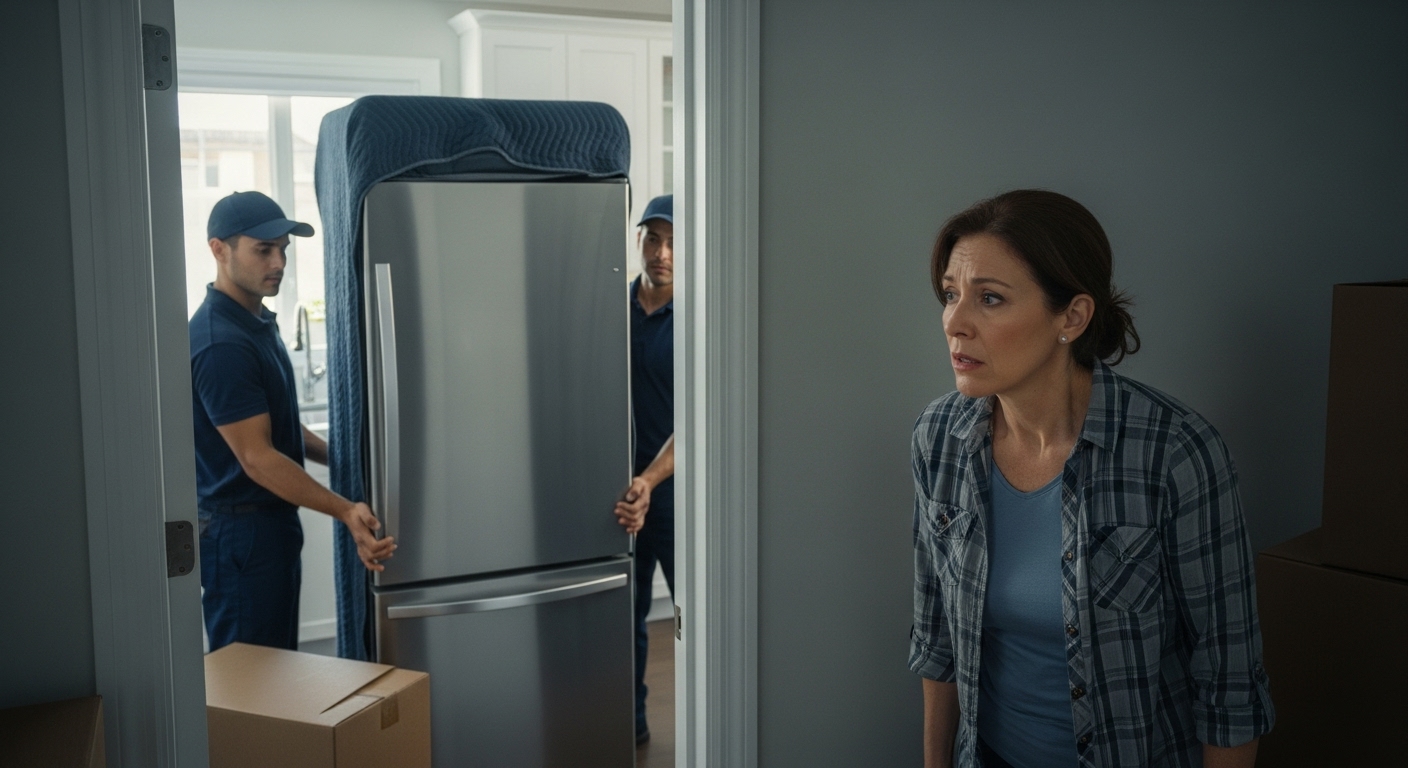
Let’s start with the big guy – your refrigerator. This bad boy needs to be unplugged a full 24 hours before moving day to allow complete defrosting. But that’s not where the prep starts. Two days before, you should begin eating down your food supplies and consuming or donating anything that won’t survive the transition. The night before unplugging, remove everything from inside, including all the shelves, drawers, and removable components. These should be wrapped separately and packed in clearly labeled boxes.
Once you unplug the fridge, prop the doors open with towels to maintain airflow and prevent mold growth. Place towels around the base to absorb melting ice and condensation – trust me, there will be more water than you expect, especially if you haven’t defrosted in a while. Clean and dry all interior surfaces thoroughly before the move to prevent odors and bacteria growth during transport.
Your washing machine requires a different but equally important preparation timeline. Start by running a final cleaning cycle with hot water and a cup of white vinegar about two days before moving. This helps remove any soap residue and mineral buildup. The day before moving, you’ll need to disconnect the water supply lines and drain all water from the hoses and internal components. If you have the original transit bolts (those big screws that came with the machine), dig them out of storage – you’ll need to reinstall them to secure the drum.
For dishwashers, run one last empty cycle with a dishwasher cleaning solution, then manually drain any remaining water from the bottom of the tub. If it’s a portable dishwasher, you’ve got additional considerations for securing the wheels and disconnecting the water adapter. Built-in dishwashers will need professional disconnection from water lines and electrical connections.
Don’t forget about your smaller appliances either. Microwaves, toasters, coffee makers, and other countertop appliances should be thoroughly cleaned and completely dried before packing. Remove all removable parts and pack them separately. Pro tip: if you still have the original boxes for smaller appliances, use them – they’re designed specifically for safe transport of that item.
Professional vs DIY Moving Equipment and Safety
Now let’s get real about the equipment situation. Moving appliances safely requires way more than just strong backs and good intentions. We’re talking about specialized tools that most homeowners don’t just have lying around in their garage. The question becomes: do you invest in buying or renting this equipment, or do you hire professionals who already have everything needed?
An appliance dolly is absolutely non-negotiable for safe appliance transport. These aren’t your basic moving dollies – they’re heavy-duty units designed to handle loads up to 700 pounds with specialized features like taller back supports, wider bases, and often stair-climbing capabilities. 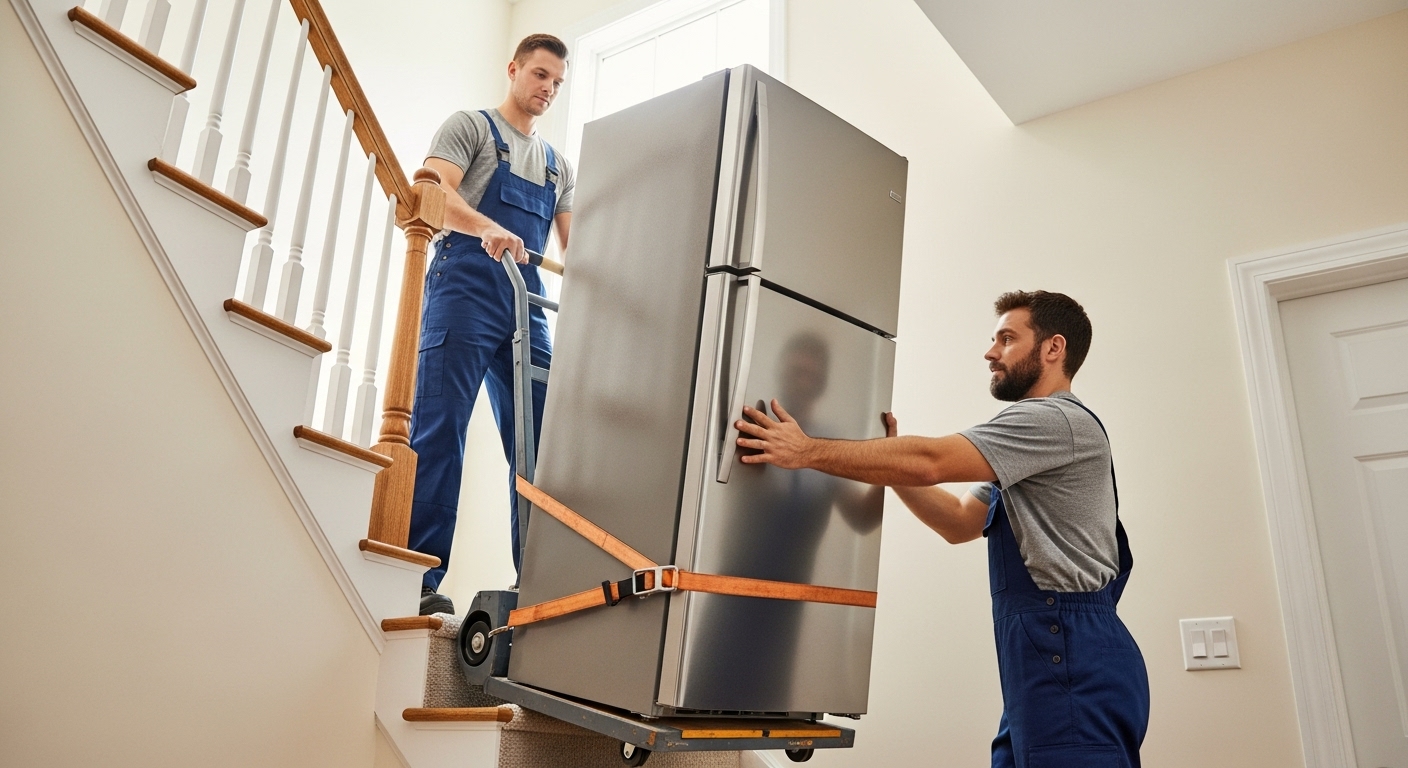 A quality appliance dolly will run you around $100-200 to buy or $30-50 per day to rent. But here’s the thing – moving an appliance isn’t just about having the dolly; it’s about knowing how to use it. Professional movers are trained in proper lifting techniques, how to balance and secure the appliance on the dolly, and how to navigate stairs, tight corners, and uneven surfaces without causing damage or injury. They also come equipped with moving blankets, straps, and floor runners to protect both your appliance and your home.
A quality appliance dolly will run you around $100-200 to buy or $30-50 per day to rent. But here’s the thing – moving an appliance isn’t just about having the dolly; it’s about knowing how to use it. Professional movers are trained in proper lifting techniques, how to balance and secure the appliance on the dolly, and how to navigate stairs, tight corners, and uneven surfaces without causing damage or injury. They also come equipped with moving blankets, straps, and floor runners to protect both your appliance and your home.
The Disconnection/Reconnection Dilemma
Here’s a crucial detail that often catches people by surprise: most moving companies will not disconnect or reconnect your appliances for liability reasons. Their job is to move items from point A to point B, not to perform tasks that require specialized knowledge of plumbing, electrical, or gas systems. This means you need to have a separate plan in place for these critical steps.
For water lines (refrigerator ice maker, washing machine, dishwasher), you can often handle the disconnection yourself if you’re comfortable shutting off the water supply and using basic tools. However, for gas appliances like your stove or dryer, you absolutely must hire a licensed and insured professional. Attempting a DIY gas disconnection is incredibly dangerous and could lead to gas leaks, fires, or explosions. It’s simply not worth the risk.
The same goes for reconnection at your new home. Don’t let the excitement of getting settled in rush you into a DIY installation. A professional appliance installer can ensure that all connections are secure, level the appliances for proper operation, and test them to make sure everything is working correctly. Here in Abbotsford, we have excellent same-day appliance installation services that can get your kitchen and laundry room up and running quickly and safely.
Insurance and Liability: Protecting Your Investment
Let’s talk money. Your appliances are some of the most expensive items you’ll be moving, so it’s essential to understand how they’re covered in case of an accident. The standard liability coverage that moving companies offer is shockingly low – typically around 60 cents per pound per item. Let’s do some quick math: if your 300-pound, $2,000 refrigerator gets damaged, you’d only be entitled to $180. That’s a massive financial hit.
This is why it’s so important to talk to your moving company about additional insurance options. Many offer “full value protection,” where they will repair or replace a damaged item or reimburse you for its current market value. While this costs more upfront, it provides invaluable peace of mind. You should also check your homeowner’s insurance policy, as some plans offer coverage for your belongings during a move, though you may need to purchase a special rider or floater policy.
Before the movers arrive, take detailed photos and videos of each appliance from all angles, documenting its current condition. Note any existing scratches or dings. This evidence will be crucial if you need to file a claim later on. Make sure you get a written copy of the insurance policy from your movers and understand the claims process before they start loading the truck.
Frequently Asked Questions (FAQs)
- Can I lay my refrigerator down to move it?
- No, this is a huge mistake! Refrigerators should always be kept upright during transport. Laying them down can cause the compressor oil to seep into the cooling lines, which can permanently damage the unit. If you must tilt it, do so as little as possible and for the shortest time.
- Do I really need to use transit bolts for my washing machine?
- Yes, absolutely. The internal drum of a washing machine is suspended by springs and can be damaged if it bounces around during the move. Transit bolts, also called shipping bolts, lock the drum in place to prevent this. If you’ve lost the original bolts, you can often order replacements from the manufacturer or a local appliance parts store.
- How soon can I plug in my refrigerator after moving it?
- After the refrigerator is in its new spot, you should let it stand upright for at least 4-6 hours before plugging it in. This allows the compressor oil and coolant to settle back into their proper places. Plugging it in too soon can cause serious damage.
- What if I notice damage after the movers have left?
- Most moving companies have a limited window (often 9 months, but check your contract) for you to file a claim. Inspect your appliances as soon as possible after delivery. Plug them in (after the appropriate waiting period for the fridge) and run a test cycle. If you find any damage or malfunction, contact the moving company immediately and provide your photo/video evidence.
Wrapping Up: Your Abbotsford Appliance Moving Checklist
Moving your major appliances doesn’t have to be a source of stress and anxiety. By following a clear plan and understanding the specific needs of each machine, you can ensure they arrive at your new Abbotsford home in perfect working order. Remember, preparation is everything. From defrosting your fridge 24 hours in advance to installing those crucial transit bolts in your washer, these steps are non-negotiable for a successful move.
Don’t be afraid to call in the professionals where they’re needed most. A licensed technician for gas disconnections and a qualified installer at your new home are smart investments in safety and functionality. And when it comes to the move itself, seriously consider the value of professional movers with the right equipment and insurance to protect your valuable investments.
Once you’re in your new space, if you run into any issues or just want the peace of mind of a professional installation, don’t hesitate to reach out. Abbotsford is home to reliable and fast appliance repair and installation experts who can help you get your new kitchen and laundry room operational in no time. Welcome home!
